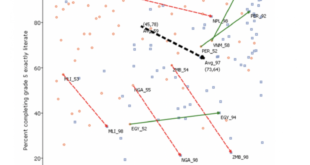Placeholder while article actions loadI work with violent young men, from Africa to the Americas — guys so far into lives of crime that a natural reaction is hopelessness. If, 10 years ago, you told me that eight weeks of therapy plus a little cash could turn a significant proportion of them away from that life, I’d have scoffed. But it’s true — as three colleagues and I demonstrated in a new working paper. What we learned in Monrovia, Liberia, holds the potential to change the way America...
Read More »A study gave cash and therapy to men at risk of criminal behavior. 10 years later, the results are in.
What if someone told you that you could dramatically reduce the crime rate without resorting to coercive policing or incarceration? In fact, what if they said you could avert a serious crime — a robbery, say, or maybe even a murder — just by shelling out $1.50? That’s such an incredibly good deal that it sounds too good to be true. But it’s been borne out by the research of Chris Blattman, Margaret Sheridan, Julian Jamison, and Sebastian Chaskel. Their new study provides experimental...
Read More »The terrible trade-off: Why less violent cities often means more powerful and organized crime
[unable to retrieve full-text content]More than half the world lives in cities, and a lot of those cities (especially those in the Americas) are plagued with homicides and crime. Americans often think this violence is an individual problem: greed, passions, feuds, and hot reactive thinking drive killers. That’s true to an extent. But this view overlooks something important: that, […] The post The terrible trade-off: Why less violent cities often means more powerful and organized...
Read More »Opioids in America
In 2019 the age-adjusted death rate from an opioid overdose was 21.6 per 100,000 people. This compares with 12.9 for kidney disease, 14.2 from suicides, 14.7 for influenza, 21.6 from diabetes, and 161.5 from heart disease (the leading cause of death in the United States). Opioid overdose deaths place in the top 10 leading causes of death in the United States. As can been from Figure 1, prior to 2015 most of these opioid deaths arose from prescription (Rx) overdoses, but after that they came...
Read More »Advances in plague research
Few doubt that the mid-fourteenth-century Afro-Eurasian plague pandemic, the Black Death, killed tens of millions of people. In western Asia and Europe, where its spread and mortality are best understood, upwards of 50% of the population is thought to have died within approximately 5 years. …The regionality of the plague’s mortality is particularly underexplored, owing to the availability of written sources and the limits of traditional historical methods. Here we pioneer a new approach, big...
Read More »Computer viruses don’t come with a return address
Is a renegade American responsible for shutting down much of North Korea’s internet? Just over a year ago, an independent hacker who goes by the handle P4x was himself hacked by North Korean spies. P4x was just one victim of a hacking campaign that targeted Western security researchers with the apparent aim of stealing their hacking tools and details about software vulnerabilities. He says he managed to prevent those hackers from swiping anything of value from him. But he nonetheless felt...
Read More »Choose your own anti-science
On Tuesday I pointed to research that the Green Revolution might be the greatest antidote to poverty and poor health in human history. The revolution continues, with more and better crops and techniques available every year. Today, however, the main hurdles aren’t technology and logistics, but rather regulation and politics. One follower, for instance, sent me to this tweet: A modern variety of Golden Rice, GR2E, is safe, high-yielding and rich in beta carotene. That hasn’t stopped anti-GMO...
Read More »The most important economic event of the past century
We estimate the impact of the Green Revolution in the developing world by exploiting exogenous heterogeneity in the timing and extent of the benefits derived from high-yielding crop varieties (HYVs). HYVs increased yields of food crops by 44 percent between 1965 and 2010. The total effect on yields is even higher because of substitution towards crops for which HYVs were available, and because of reallocation of land and labor. Beyond agriculture, our baseline estimates show strong, positive,...
Read More »Remembrances of an Indian development economist
The statistical assistants at ISI were literally called ‘computers’ (I was a bit taken aback when on the first day a man came to see me and said “I am your computer, sir”). One day when I was chatting with this human ‘computer’, he said some years back he had worked with a foreign professor who was rather short-tempered and used to scream at him for the slightest delay or lapse. (It so happened that I knew this professor). I said he should have protested if the professor was unnecessarily...
Read More »Enrolling more kids in school is easy, teaching them is hard
We use literacy tests in survey data to construct long-term trends in literacy for 87 developing countries, spanning birth cohorts from the 1950s to 2000. We show that over this period literacy rates have increased substantially, but virtually all progress has been due to the increase in access to school rather than any improvement school quality, which we define as the propensity for schooling to generate literacy after five years of schooling. Overall, school quality is low in developing...
Read More » Heterodox
Heterodox


